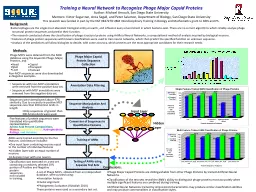

Author Michael Arnoult San Diego State University Mentors Victor Seguritan Anca Segall and Peter Salamon Department of Biology San Diego State University Methods Bacteriophages are the single most abundant biological entity on earth and influence every environment in which bacteria exi ID: 913463
Download Presentation The PPT/PDF document "Training a Neural Network to Recognize P..." is the property of its rightful owner. Permission is granted to download and print the materials on this web site for personal, non-commercial use only, and to display it on your personal computer provided you do not modify the materials and that you retain all copyright notices contained in the materials. By downloading content from our website, you accept the terms of this agreement.
Slide1
Training a Neural Network to Recognize Phage Major Capsid Proteins
Author: Michael Arnoult, San Diego State University
Mentors: Victor Seguritan, Anca Segall, and Peter Salamon, Department of Biology, San Diego State University
Methods:
Bacteriophages are the single most abundant biological entity on earth, and influence every environment in which bacteria exist. There are no current algorithms which reliably analyze phage structural protein sequences and predict their function.
The research conducted allows the classification of phage structural proteins using
Artificial Neural Networks, a computational method of analysis inspired by biological neurons.
Features of phage protein sequences with known classifications were used to train neural networks, which then predict the specified function an unknown sequence.Analysis of the predictions will allow biologists to decide, with some accuracy, which proteins are the most appropriate candidates for their research needs.
Background:
Training of ANNs
Annotation Data Filtering
Conversion of Sequences to Quantitative Features
Phage Major Capsid Protein Sequence Collection
Phage MCPs were obtained from the NCBI database using the keywords Phage, Major, Proteins, and:
Testing of ANNs using Separate Test Sets
Sequence Manipulation And Analysis
Sequences with non-MCP annotations were removed from the positive data-set,
Sequences with MCP annotations were removed from the negative data-set.
Sequences were dereplicated above 97% similarity. Due to a scarcity in positive MCP sequences less than 300 Amino Acids in length:
Only sequences of greater than 300 Amino Acids were used.
Five features of protein sequences were translated into quantitative representations:
Amino Acid Percent Compositions,
Masses, Isoelectric Points, Hydrophobicity Ratings, and Volumes.
ANNs were trained according to the five features. Architecture included: One input layer containing neurons equal to the number of individual features A hidden layer with an equal number of neuronsA decision layer with one neuron.
Classification was executed on a test set containing a randomly selected 20% portion of Positive and Negative
Head
ShellCoat
CapsidProcapsidProhead
Non-MCP sequences were also downloaded as Negative examples.
Input Layer
Hidden Layer
Phage Major Capsid Proteins are distinguishable from other Phage Proteins by trained Artificial Neural Networks.
Classification of the test sets reveal the ANN's ability to distinguish phage proteins most accurately when multiple significant features are combined during training.
Artificial Neural Networks trained by Amino Acid characteristics may produce similar classification abilities and may produce commonalities in classification styles.
Conclusions:
This research was funded in part by the NSF 0827278 UBM Interdisciplinary Training in Biology and Mathematics grant to AMS and PS.
A set of Phage MCPs, obtained from an independent database, were curated using:
Annotation Analysis
Clustal alignment
Phylogenetic Evaluation (Rizkallah 2010).
These proteins were used as a secondary test set.
protein sequences, not included in training.